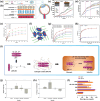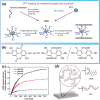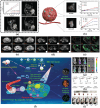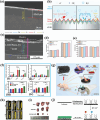Layered Double Hydroxides: Recent Progress and Promising Perspectives Toward Biomedical Applications
- PMID: 38501901
- PMCID: PMC11132086
- DOI: 10.1002/advs.202306035
Layered Double Hydroxides: Recent Progress and Promising Perspectives Toward Biomedical Applications
Abstract
Layered double hydroxides (LDHs) have been widely studied for biomedical applications due to their excellent properties, such as good biocompatibility, degradability, interlayer ion exchangeability, high loading capacity, pH-responsive release, and large specific surface area. Furthermore, the flexibility in the structural composition and ease of surface modification of LDHs makes it possible to develop specifically functionalized LDHs to meet the needs of different applications. In this review, the recent advances of LDHs for biomedical applications, which include LDH-based drug delivery systems, LDHs for cancer diagnosis and therapy, tissue engineering, coatings, functional membranes, and biosensors, are comprehensively discussed. From these various biomedical research fields, it can be seen that there is great potential and possibility for the use of LDHs in biomedical applications. However, at the same time, it must be recognized that the actual clinical translation of LDHs is still very limited. Therefore, the current limitations of related research on LDHs are discussed by combining limited examples of actual clinical translation with requirements for clinical translation of biomaterials. Finally, an outlook on future research related to LDHs is provided.
Keywords: biomedical application; drug delivery; exchangeability; layered double hydroxides; nanotheranostics.
© 2023 The Authors. Advanced Science published by Wiley‐VCH GmbH.
Conflict of interest statement
P.v.R also is a co‐founder, scientific advisor, and shareholder in BiomACS BV, a biomedical‐oriented screening company. The authors declare no other conflict of interest. The authors declare no competing financial interest.
Figures
















Similar articles
-
Layered double hydroxide-based nanomaterials for biomedical applications.Chem Soc Rev. 2022 Jul 18;51(14):6126-6176. doi: 10.1039/d2cs00236a. Chem Soc Rev. 2022. PMID: 35792076 Review.
-
Layered double hydroxides for regenerative nanomedicine and tissue engineering: recent advances and future perspectives.J Nanobiotechnology. 2025 May 22;23(1):370. doi: 10.1186/s12951-025-03448-1. J Nanobiotechnology. 2025. PMID: 40405242 Free PMC article. Review.
-
A review on optical sensors based on layered double hydroxides nanoplatforms.Mikrochim Acta. 2021 Feb 11;188(3):80. doi: 10.1007/s00604-021-04739-8. Mikrochim Acta. 2021. PMID: 33576899 Review.
-
Nanoarchitectured two-dimensional layered double hydroxides-based nanocomposites for biomedical applications.Adv Drug Deliv Rev. 2022 Jul;186:114270. doi: 10.1016/j.addr.2022.114270. Epub 2022 Apr 12. Adv Drug Deliv Rev. 2022. PMID: 35421521 Review.
-
Layered double hydroxides as the next generation inorganic anion exchangers: Synthetic methods versus applicability.Adv Colloid Interface Sci. 2017 Jul;245:62-80. doi: 10.1016/j.cis.2017.04.013. Epub 2017 Apr 25. Adv Colloid Interface Sci. 2017. PMID: 28477867 Review.
Cited by
-
Materials Containing Single-, Di-, Tri-, and Multi-Metal Atoms Bonded to C, N, S, P, B, and O Species as Advanced Catalysts for Energy, Sensor, and Biomedical Applications.Adv Sci (Weinh). 2024 Sep;11(33):e2403197. doi: 10.1002/advs.202403197. Epub 2024 Jul 1. Adv Sci (Weinh). 2024. PMID: 38946671 Free PMC article. Review.
-
Advanced Nanobiocomposite Hydrogels Incorporating Organofunctionalized LDH for Soft Tissue Engineering Applications.Polymers (Basel). 2025 Feb 19;17(4):536. doi: 10.3390/polym17040536. Polymers (Basel). 2025. PMID: 40006198 Free PMC article.
-
A Smart Nanomedicine Unleashes a Dual Assault of Glucose Starvation and Cuproptosis to Supercharge αPD-L1 Therapy.Adv Sci (Weinh). 2025 Jan;12(4):e2411378. doi: 10.1002/advs.202411378. Epub 2024 Dec 4. Adv Sci (Weinh). 2025. PMID: 39632613 Free PMC article.
-
Bioactive LDH nanoplatforms for cancer therapy: Advances in modulating programmed cell death.Mater Today Bio. 2025 Jul 26;34:102139. doi: 10.1016/j.mtbio.2025.102139. eCollection 2025 Oct. Mater Today Bio. 2025. PMID: 40761508 Free PMC article. Review.
-
DNA binding effects of LDH nanozyme for aseptic osteolysis mitigation through STING pathway modulation.J Nanobiotechnology. 2025 May 27;23(1):384. doi: 10.1186/s12951-025-03458-z. J Nanobiotechnology. 2025. PMID: 40426255 Free PMC article.
References
Publication types
MeSH terms
Substances
Grants and funding
LinkOut - more resources
Full Text Sources
